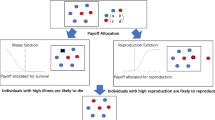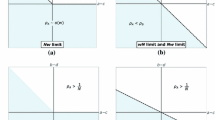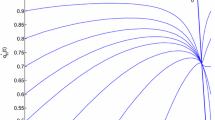Abstract
Evolutionary game dynamics of two strategies in finite population is studied by continuous probabilistic approach. Besides frequency dependent selection, mutation was also included in this study. The equilibrium probability density functions of abundance, expected time to extinction or fixation were derived and their numerical solutions are calculated as illustrations. Meanwhile, individual-based computer simulations are also done. A comparison reveals the consistency between theoretical analysis and simulations.
Similar content being viewed by others
References
Antal, T., Scheuring, I., 2006. Fixation of strategies for an evolutionary game in finite populations. Bull. Math. Biol. 68, 1923–1944.
Axelrod, R., 1984. The Evolution of Cooperation. Basic Books, New York.
Brandt, H., Hauert, C., Sigmund, K., 2006. Punishing and abstaining for public goods. Proc. Natl. Acad. Sci. USA 103, 495–497.
Doebeli, M., Hauert, C., 2004. Models of cooperation based on the Prisoner’s Dilemma and the Snowdrift game. Ecol. Lett. 8, 748–766.
Gardiner, C.W., 1983. Handbook of Stochastic Methods for Physics, Chemistry and the Natural Sciences. Springer, Berlin.
Hauert, C., De Monte, S., Hofbauer, J., Sigmund, K., 2002. Volunteering as red queen mechanism for cooperation in public goods games. Science 296, 1129–1132.
Hofbauer, J., Sigmund, K., 1998. Evolutionary Games and Population Dynamics. Cambridge University Press, Cambridge.
Hofbauer, J., Schuster, P., Sigmund, K., 1979. A note on evolutionarily stable strategies and game dynamics. J. Theor. Biol. 81, 609–612.
Imhof, L.A., Nowak, M.A., 2006. Evolutionary game dynamics in a Wright–Fisher process. J. Math. Biol. 52, 667–681.
Imhof, L. A, Fudenberg, D., Nowak, M.A., 2005. Evolutionary cycles of cooperation and defection. Proc. Natl. Acad. Sci. USA 102, 10797–10800.
Lieberman, E., Hauert, C., Nowak, M.A., 2005. Evolutionary dynamics on graphs. Nature 433, 312–316.
Maynard Smith, J., 1982. Evolution and the Theory of Games. Cambridge University Press, Cambridge.
Nowak, M.A., 2006. Five rules for the evolution of cooperation. Science 314, 1560–1563.
Nowak, M.A., May, R.M., 1992. Evolutionary games and spatial chaos. Nature 359, 826–829.
Nowak, M.A., Sigmund, K., 2004. Evolutionary dynamics of biological games. Science 303, 793–799.
Nowak, M.A., Sasaki, A., Taylor, C., Fudenberg, D., 2004. Emergence of cooperation and evolutionary stability in finite populations. Nature 428, 646–650.
Taylor, P.D., Jonker, L.B., 1978. Evolutionarily stable strategies and game dynamics. Math. Biosci. 40, 145–156.
Taylor, C., Fudenberg, D., Sasaki, A., Nowak, M.A., 2004. Evolutionary game dynamics in finite populations. Bull. Math. Biol. 66, 1621–1644.
Traulsen, A., Claussen, J.C., Hauert, C., 2005a. Coevolutionary dynamics: from finite to infinite populations. Phys. Rev. Lett. 95, 238701.
Traulsen, A., Sengupta, A.M., Nowak, M.A., 2005b. Stochastic evolutionary dynamics on two levels. J. Theor. Biol. 235, 393–401.
Traulsen, A., Pacheco, J.M., Imhof, L.A., 2006a. Stochasticity and evolutionary stability. Phys. Rev. E 74, 021905.
Traulsen, A., Nowak, M.A., Pacheco, J.M., 2006b. Stochastic dynamics of invasion and fixation. Phys. Rev. E 74, 011909.
Traulsen, A., Nowak, M.A., Pacheco, J.M., 2007a. Stochastic payoff evaluation increases the temperature of selection. J. Theor. Biol. 244, 349–356.
Traulsen, A., Pacheco, J.M., Nowak, M.A., 2007b. Pairwise comparison and selection temperature in evolutionary game dynamics. J. Theor. Biol. 246, 522–529.
Weibull, J.W., 1995. Evolutionary Game Theory. MIT Press, Cambridge.
Author information
Authors and Affiliations
Corresponding author
Rights and permissions
About this article
Cite this article
Gao, M. Continuous Probabilistic Analysis to Evolutionary Game Dynamics in Finite Populations. Bull. Math. Biol. 71, 1148–1159 (2009). https://doi.org/10.1007/s11538-009-9397-7
Received:
Accepted:
Published:
Issue Date:
DOI: https://doi.org/10.1007/s11538-009-9397-7




